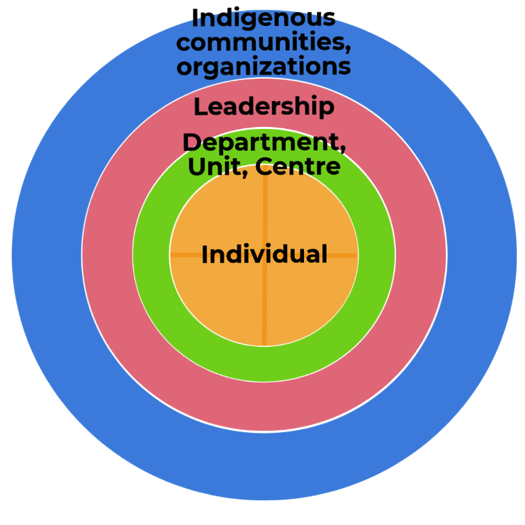The following is an excerpt from Pulling Together: A Guide for Front-Line Staff, Student Services, and Advisors by Ian Cull, Robert L. A. Hancock, Stephanie McKeown, Michelle Pidgeon, and Adrienne Vedan.
Indigenization and Institutional Interconnections
Indigenization in practice is deeply grounded in the traditions and cultural protocols of the traditional landholders that an institution is built upon; it is informed by the diversity of First Nations, Métis, and Inuit of Canada.

Figure 2.2 provides the institutional interconnections to Indigenization. It shows that individuals within the institution have specific roles and responsibilities that are interconnected to their unit/department/centre goals and purpose. The focus and practices of the department are then influenced by the institutional leadership, such as direct supervisors, senior executive and other community partners. The relationships that an institution, unit, and staff have with local Indigenous communities and organizations within and outside the institution are important. In fact, Indigenization of cannot occur without these critical relationships informing each step and the entire educational process.
Building Responsible Relationships
We can accomplish so much more working together than working on our own. This is true for teams, units, departments, and institutions. It is important to be engaged in working for the common good, within the considerations of decolonization and Indigenization, and to recognize our individual and institutional role in ensuring responsibility and accountability.
A key principle of decolonization and Indigenization is that each person within an institutional community is responsible to these relationships. Every front-line staff member and student affairs professional is accountable to their unit and director, who are then accountable to the senior leadership. The interconnections of the relationships we have working within an institution and across the British Columbia post-secondary system is critically important to improve Indigenous student success in this province.
Recognizing that each of us is part of the relationship towards truth and reconciliation, we can enact it through our participation and active engagement. This engagement builds upon the concept of reciprocal relationships. As defined by Verna Kirkness and Ray Barnhardt (1991), we “are in a position to create a new kind of education, to formulate new paradigms or explanatory frameworks that help us establish a greater equilibrium and congruence between the literate view of the world and the reality we encounter when we step outside the walls of the ‘Ivory Tower’” (p. 12). Essentially, these reciprocal relationships create opportunities for learning between Indigenous and non-Indigenous people that improve understanding and inclusion of Indigenous ways of knowing and being within the academy. In ways similar to the TRC (2015) Calls to Action [PDF],[1] this collective reciprocal responsibility ensures that we are all part of the journey as a community.
Connecting with others working toward Indigenization
You can find others in your institution who are working toward Indigenization, decolonization, and reconciliation, and build connections between your existing communities and create new and different relationships. Many post-secondary institutions have Indigenous plans or strategic documents that describe their commitment to Indigenization. These plans vary widely from institution to institution, and some institutions are working on new or revised versions. There may be opportunities to get involved in this work where your perspective as a front-line worker is important to share.
Learn more:
- Indigenization Guide: Promising Practices and Policies to Support Student Transformation
- Indigenization Guide: Myths that Impact Indigenous Student Experience
Media Attributions
- Fig 2.2: Institutional Interconnections to Indigenization © M. Pidgeon is licensed under a CC BY (Attribution) license
- TRC (2015) Calls to Action: http://www.trc.ca/websites/trcinstitution/File/2015/Findings/Calls_to_Action_English2.pdf ↵
